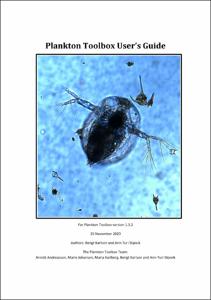Plankton Toolbox User’s Guide: for Plankton Toolbox Version 1.3.2/1.3.3.

Average rating
votes
Date
2020Author
Karlson, Bengt
Skjevik, Ann-Turi
Status
PublishedPages
36pp.
Metadata
Show full item recordAbstract
Plankton form the base of the food web in most aquatic ecosystems. There is a need to estimate the biomass, abundance and the biodiversity of plankton organisms. Eutrophication, climate change, invasive species and harmful algal blooms are some of the reasons to monitor plankton. Microscope based methods are currently the standard in several monitoring programs including HELCOM-COMBINE, for the Baltic Sea, and OSPAR-JAMP, for North Eastern Atlantic Ocean covering the area between the Azores and the Arctic Ocean. Phyto- and zooplankton samples are collected using e.g. water sampling devices, hoses or nets. Data have been collected for decades and large data sets are available e.g. at international and national data centres. To work with the data in a consistent way may be difficult without the right tools.
The Plankton Toolbox is a free tool for aquatic scientists, and others, working with phyto- and zooplankton data. It is available for MacOS and Windows. Plankton Toolbox makes it rel.....
Resource URL
https://data.smhi.se/oce/SLW/plankton_toolbox_1_3_3/Plankton_Toolbox_users_guide_1_3_3_2020-11-25.pdfhttp://nordicmicroalgae.org/tools
Publisher
Swedish Meteorological and Hydrological InstituteGothenburg, Sweden
Document Language
enSustainable Development Goals (SDG)
14.aEssential Ocean Variables (EOV)
Zooplankton biomass and diversityPhytoplankton biomass and diversity
Citation
Karlson, B. and Skjevik, A-T. (2020) Plankton Toolbox User’s Guide version 1.3.2. Gothenburg, Sweden, Swedish Meteorological and Hydrological Institute, 36pp. DOI: http://dx.doi.org/10.25607/OBP-1660Collections
The following license files are associated with this item:
 Repository of community practices in Ocean Research, Applications and Data/Information Management
Repository of community practices in Ocean Research, Applications and Data/Information Management
